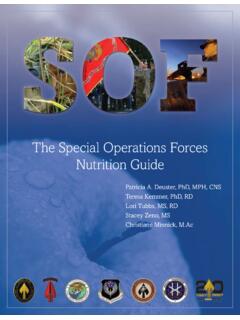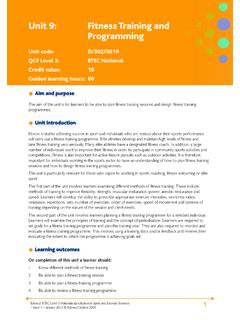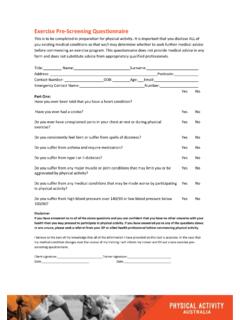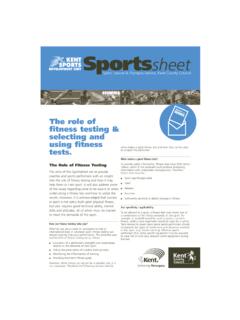Transcription of Naval Special Warfare Physical Training Guide - Navy SEALs
1 Naval Special Warfare Physical Training GuideDISCLAIMER: Preparation for this Training can be equally strenuous. You should consult a physician before you begin any strenuous exer-cise program, such as the one described here, or any diet modification, especially if you have or suspect that you may have heart disease, high blood pressure, diabetes, or any other adverse medical conditions. If you feel faint or dizzy at any time while performing any portion of this Training program, stop immediately and seek medical evaluation. The United States Government and any service member or civilian employed by the United States Government disclaims any liability, personal or professional, resulting from the misapplication of any Training procedure, technique, or guidance described in this Training Guide Page Training Guide Page Naval Special Warfare Physical Training Guide is designed to assist anyone who wants to improve his fit-ness in order to take and pass the Physical Screening Test (PST) and succeed at Basic Underwater Demolition/SEAL (BUD/S).
2 This Guide provides infor-mation about the type of train-ing required to properly pre-pare for the rigors of BUD/S, and it offers a tailorable 26-week Training plan that should help a person with average fitness prepare for Training and avoid injury. Most of your cardio-vascular exercise should focus on running and swimming, and your strength and calisthenics Training should be done to develop the necessary muscular strength and endurance for maximum pull-ups, push-ups and sit-ups as they are necessary for success at BUD/S. Cross- Training such as cycling, rowing and hiking is useful to rehabilitate an injury, to add variety or to supplement your basic Training .
3 Work to improve your weakest areas. If you are a solid runner but a weak swim-mer, don t spend all your time running just because you are good at it. Move out of your comfort zone, and spend enough time in the water to become a solid swimmer as well. The intensity of LSD work is low to moder-ate, so your pace should feel relatively easy and relaxed. These workouts build endurance and provide relative recovery between more intense sessions. To determine the appropri-ate intensity, use the Talk Test. You should be able to talk comfortably in short sentences or phrases while Training , drawing breath be-tween phrases.
4 If you can t speak, you are working too hard, and if you can speak con-tinually, you are not working hard enough. For LSD workouts, focus more on duration than intensity. If you are exceptionally fit, you might perform 40-90 minutes of continuous move-ment in one session. A practical goal to pre-pare for BUD/S is to build up to comfortably running 5-6 miles or swimming miles without Training Guidelines Your workouts should be Planned and organized Gradual, steady and continual Consistent Specific Balanced 1 Long Slow Distance workout for both running and swimming 1 Continuous High Intensity workout for both running and swimming 1 Interval workout for both running and swimming 4-5 Calisthenics Routines 4-6 Strength Training Sessions 2-3 each for upper and lower body 4-5 Core Exercise Routines Daily Flexibility Routines Specific injury prevention exercises as needed These sessions typically involve moving for 15-20 minutes without stopping at a pace
5 Approximately 90-95% of the maximal pace you could hold for that duration. The work-out should be very demanding but not totally exhausting. On a scale of 1-10, with 10 be-ing the greatest effort possible, the workout Long Slow Distance (LSD)Workouts Continuous High Intensity (CHI)We e k l y Wo r k o u t Su m m a r yPhysical Training Guide Page Training Guide Page (INT) should feel like 8-9. If you are at a low fitness level, one repetition of 15-20 minutes is suf-ficient. As your fitness improves, 2-3 repeti-tions may be required. When performing more than one repetition, allow sufficient recovery between repetitions so you can maintain the desired intensity of 90-95% of maximal pace.
6 A reasonable recovery period is approxi-mately half of the work time. During this time, keep moving at a low intensity slow jog, brisk walk or easy stroke. Do not come to a complete sessions alternate short, intense work intervals with periods of recovery. The format consists of running 1/4-mile intervals or swimming 100-yard intervals, allowing a recovery period of 2-2 1/2 times the amount of time it takes to perform the work interval. Your intensity or pace should be slightly fast-er than the pace of your most recent run or 500-yard swim. For running, your 1/4-mile interval pace should initially be about 4 seconds faster than your base pace, and for swimming, your 100-yard interval pace should initially be 2 seconds faster than your base.
7 For example, if you recently completed a run in 10:30 1/4 mile base pace of 1:45 your interval Training pace should be about 1:41. If you completed a 500-yard swim in 10:30 100-yard base pace of 2:06 intervals should be approximately 2:04. Begin your interval workouts with 4 in-tervls per session, and build progressively toward completing 10 intervals. Do not run or swim more than 10 intervals during an interval session. When you can complete 10 intervals in the prescribed times, work on gradually performing the intervals a little faster each week.
8 Work on consistency, trying to keep little variation between your fastest and slowest interval and pacing RunSwimIf your current pace isThen your workout isIf your current pace isThen your workout is1/4-mile repeat timerecovery time100-yard repeat timerecovery time8:00-8:301:16-1:212:32-3:238:00-8:30 1:34-1:403:08-4:108:30-9:001:21-1:262:42 -3:358:30-9:001:40-1:463:20-4:259:00-9:3 01:26-1:312:52-3:489:00-9:301:46-1:523:3 2-4:409:30-10:001:31-1:363:02-4:009:30-1 0:001:52-1:583:44-4:5510:00-10:301:36-1: 413:12-4:1310:00-10:301:58-2:043:56-5:10 10:30-11:001:41-1:463:22-4:2510:30-11:00 2:04-2:104:08-5:2511:00-11:301:46-1:513: 32-4:3811:00-11:302:10-2:164:20-5:4011:3 0-12:001:51-1:563:42-4:5011:30-12:002:16 -2:224:32-5:5512:00-12:301:56-2:013:52-5 :0312:00-12:302:22-2:284:44-6:1012:30-13 :002:01-2:064:02-5:1512:30-13:002:28-2:3 44:56-6:2513:00-13:302:06-2:114:12-5:281 3:00-13:302:34-2:405:08-6:4013:30-14:002 :11-2:164:22-5:4013:30-14:002:40-2:465:2 0-6:5514:00-14:302:16-2:214:32-5:5314:00 -14:302:46-2:525:32-7:1014:30-15:002:21- 2:264:42-6:0514:30-15:002:52-2:585:44-7: 2515:00-15:302:26-2:314:52-6:1815:00-15: 302:58-3.
9 045:56-7:4015:30-16:002:31-2:365:02-6:30 15:30-16:003:04-3-106:08-7:55 Table 1 Interval PacesTable 1 provides appropriate paces and recovery times for interval Training Guide Page Training Guide Page to be fastest at the end of the work-out. Every 4th or 5th week, it may be benefi-cial to increase your intensity using shorter, more frequent intervals. For example, 16-20 x 220-yard running intervals or 16-20 x 50-yard swimming intervals. Allow enough recovery time to maintain the proper work intensity, without taking excessive time or wasting time.
10 To promote faster, more complete recovery, use some active recovery, such as brisk walking, easy stroking or slow jog-ging for part of the time between intervals. During BUD/S and for the PST, you will be required to perform numerous push-ups, sit-ups and pull-ups. You should prepare specifically for these exercises. Using proper technique, perform sets of push-ups, sit-ups and pull-ups 4-5 times per week, resting 1-2 minutes between sets. Though the PST re-quires the exercises to be performed as rapidly as possible, you should perform most of your Training exercises in a slow and controlled manner.







